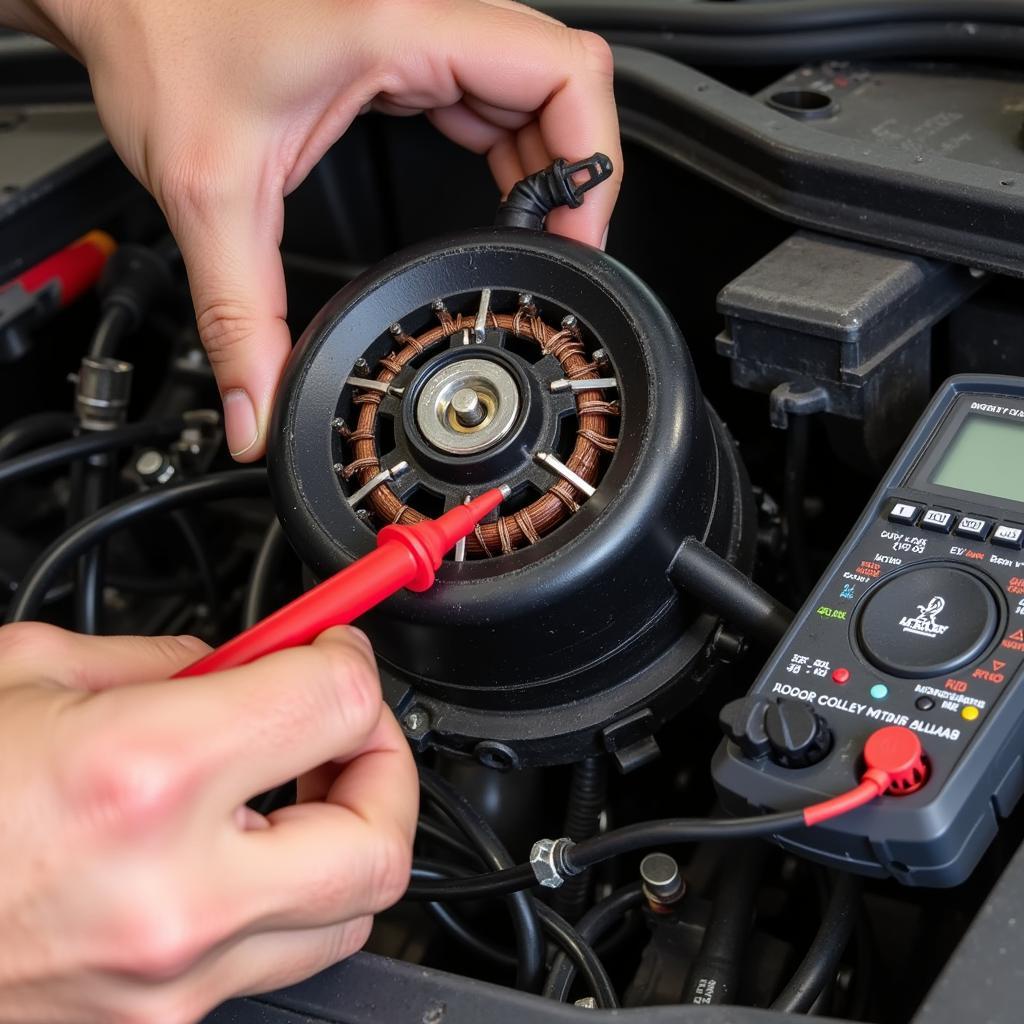Car Auxiliary Fan Problems can lead to overheating, reduced AC performance, and even engine damage. Understanding the causes, symptoms, and solutions for these issues is crucial for maintaining your vehicle’s health and preventing costly repairs. This guide will help you diagnose and fix common auxiliary fan problems, whether you’re a car owner, mechanic, or automotive technician.
Understanding the Car Auxiliary Fan
The auxiliary fan, also known as the electric cooling fan, plays a vital role in regulating your engine’s temperature, especially at low speeds or when idling. Unlike the primary engine fan, which is mechanically driven by the engine, the auxiliary fan is electrically powered and controlled by a temperature sensor. When the engine reaches a certain temperature, the sensor triggers the fan to turn on, drawing air through the radiator and helping to dissipate heat.
Common Car Auxiliary Fan Problems
Several issues can affect the auxiliary fan’s operation. These range from simple fixes like a blown fuse to more complex problems requiring professional attention.
Faulty Fan Motor
The most common car auxiliary fan problem is a malfunctioning fan motor. This could be due to worn-out brushes, a seized bearing, or a burnt-out winding. If the motor is faulty, the fan won’t spin, even when the engine is hot.
Blown Fuse or Relay
A blown fuse or a faulty relay can interrupt the power supply to the fan motor. This is a relatively simple fix, often involving just replacing the fuse or relay. Always check your owner’s manual for the correct fuse or relay location and amperage.
Malfunctioning Temperature Sensor
The temperature sensor is responsible for signaling the fan to turn on. If the sensor fails, it may not activate the fan, leading to overheating. Testing the sensor with a multimeter can help determine if it’s functioning correctly.
Wiring Issues
Damaged or corroded wiring can prevent the fan from receiving power or the sensor from sending signals. Inspect the wiring harness for any signs of damage, and repair or replace any faulty wires.
Coolant Level
Believe it or not, low coolant levels can also trigger auxiliary fan problems. When the coolant level is insufficient, the engine can overheat, causing the fan to run constantly and potentially burn out the motor.
 Inspecting a Car Auxiliary Fan Motor for Damage
Inspecting a Car Auxiliary Fan Motor for Damage
Diagnosing Car Auxiliary Fan Problems
Diagnosing the specific cause of your car auxiliary fan problem requires a systematic approach. Start by visually inspecting the fan, checking for any obvious signs of damage. Next, check the fuse and relay. If those are fine, move on to testing the temperature sensor and wiring.
How Can I Tell if My Auxiliary Fan is Bad?
If your car is overheating, especially at low speeds or idle, and the fan isn’t running, it’s a good indication of a problem. You can also use a multimeter to test the fan motor directly.
Why is My Car Auxiliary Fan Not Working?
There are several reasons why your car auxiliary fan might not be working, including a faulty motor, blown fuse, bad relay, malfunctioning temperature sensor, or wiring issues. A proper diagnosis is essential to determine the exact cause.
Fixing Car Auxiliary Fan Problems
Once you’ve identified the problem, you can begin the repair process. Replacing a fuse or relay is a straightforward task. However, replacing the fan motor, temperature sensor, or repairing wiring may require more advanced mechanical skills.
How to Replace a Car Auxiliary Fan Motor
Replacing the fan motor often involves removing the fan assembly, disconnecting the electrical connector, and installing the new motor. Consult your owner’s manual or a repair manual for specific instructions for your vehicle.
 Replacing a Car Auxiliary Fan Relay
Replacing a Car Auxiliary Fan Relay
How to Test a Car Auxiliary Fan Temperature Sensor
Testing the temperature sensor requires a multimeter. You’ll need to measure the resistance of the sensor at different temperatures to see if it falls within the specified range.
“A common mistake is assuming the fan motor is bad without checking the simpler components first, like the fuse and relay. These are often overlooked but easy to check and replace,” says John Miller, Senior Automotive Technician at Miller’s Auto Repair.
Preventing Car Auxiliary Fan Problems
Regular maintenance can help prevent auxiliary fan problems. Keep your cooling system clean and ensure the coolant level is topped off. Inspecting the fan and its wiring periodically can also help identify potential issues before they become major problems.
“Preventive maintenance is key to avoiding costly repairs down the road. A simple check of the cooling system and fan can save you a lot of trouble in the long run,” advises Sarah Johnson, Lead Mechanic at Johnson’s Automotive Solutions.
Conclusion
Car auxiliary fan problems can be frustrating, but understanding the common causes and solutions can help you tackle these issues effectively. Whether it’s a simple fuse replacement or a more complex motor replacement, addressing these problems promptly will keep your engine running cool and prevent more serious damage. For further assistance or expert advice on your specific vehicle, feel free to contact AutoTipPro at +1 (641) 206-8880. Our office is located at 500 N St Mary’s St, San Antonio, TX 78205, United States. We’re always here to help!
FAQ
- How often should I check my car’s auxiliary fan?
- Can I drive my car with a faulty auxiliary fan?
- What are the signs of a bad auxiliary fan relay?
- How much does it cost to replace a car auxiliary fan motor?
- How can I test my car’s auxiliary fan myself?
- Is it difficult to replace a car auxiliary fan temperature sensor?
- What is the difference between the primary fan and the auxiliary fan?





Leave a Reply